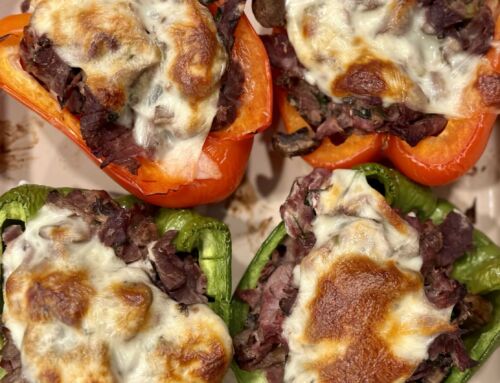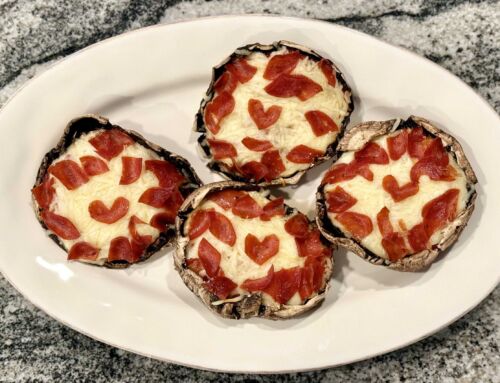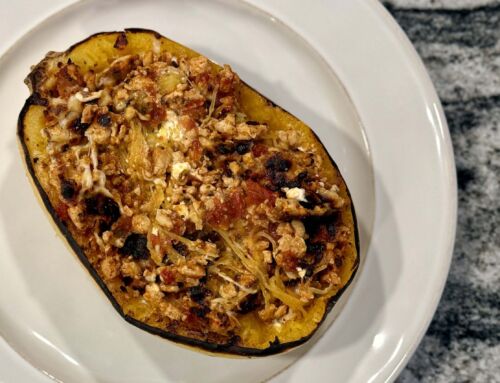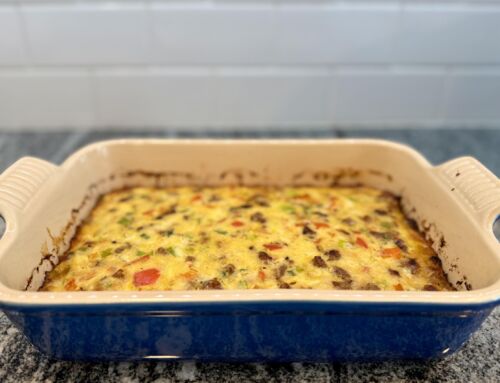Upon eating the leftovers, I might have exclaimed “osso buco, where have you been all of my life?” It’s not likely that I would have ordered this in a restaurant but it may have been a part of a set menu for a wine dinner or other event. In any case, please know that I had never made it at home until this past weekend.
Ed picked out an osso buco recipe from an old favorite, Julee Rosso and Sheila Lukins’ New Basics Cookbook (1989), which was meant for a small dinner party (something we are clearly not having these days). Inspired, I looked at a bunch of recipes and settled on one from David Rosengarten’s The Dean & Deluca Cookbook (1996). I hadn’t made anything from this cookbook in a while and loved seeing the inscription from my sister, Dixie, when she gifted it to me for my birthday in 1997 (I was still in my 20s – ha!).
I want to be perfectly clear – this is not a difficult recipe. If you follow the directions and don’t rush the braising process, you will be rewarded with wonderfully flavorful and tender veal; this I promise you.
‘Osso buco’ is Italian for ‘hole in the bone.’ It refers to the marrow hole in the center of the veal (or beef) shank bone. The cut of meat that is traditionally used for the dish comes from the top of the shin, which is cross-cut in about 1 to 1-1/2-inch thick slices. I went to my local butcher (Worrell’s in Malvern, PA) and asked for an osso buco cut of veal and they had just what I needed in their freezer. I mention that in case you need to plan ahead. You could use whole shanks, but it will not be the same as you’ll miss out on the marrow. We were without marrow spoons (Ed did order some after our meal) but were able to use a steak knife to get the marrow out. Once cooked, it’s soft, rich and melts in your mouth like butter.
The veal was so tender that it fell away from the bone and into pieces. I now know that I should have tied it around the middle with butcher’s twine (watch this short video to see how it’s done). This is more for presentation – the taste will still be wonderful if you don’t have twine.
Once you brown the veal shanks (in regular or gluten-free flour), sauté onions, carrots, celery (this mixture is known as ‘mirepoix’ in French) and garlic. Then you add white wine, a handful of herbs and whole tomatoes. The ingredient that ties it all together is lemon zest – used as part of the braising sauce and as part of a gremolata (parsley, garlic and lemon zest) topping added just before serving. Make sure you use the lemon zest in both places.
You don’t need more than one veal shank per person. Even if you’re cooking for two, I’d recommend making the full recipe so you have leftovers. Ed said the leftovers were even better. Braised meat is usually better a day after it’s prepared, so you may want to make this advance before serving it the first time. You can also freeze the leftovers and slowly reheat in a covered pan or use a sous vide (cook at 167˚F for about 90 minutes if refrigerated or 2 hours if frozen).
Osso buco is traditionally served with Risotto Milanese, but it also goes well with any type of pasta. We served it with pan fried gluten-free gnocchi – follow the technique in this recipe. (just use oil if serving it with osso buco).
Given that ‘osso buco’ is a cut of meat and not specific to one animal, I also found recipes for beef, lamb, and venison osso buco. Lamb osso buco is next on my list.
| Veal Osso Buco | Print |
- ½ cup all-purpose flour or gluten-free all-purpose flour (see Notes)
- Kosher salt and freshly ground pepper
- 5 tablespoons olive oil (divided)
- 4 center cut slices veal shanks (each about 1-1/2 inches thick)
- 1 medium yellow onion, diced
- 3 medium carrots, diced
- 3 medium celery stalks, diced
- 2-1/2 teaspoons finely minced garlic, divided
- 2 bay leaves
- ¾ cup dry white wine
- Zest from one lemon, divided (~ 2 teaspoons)
- ¾ cup Beef Stock (may need extra)
- 28 ounces whole San Marzano tomatoes or plum tomatoes (with juices)
- 1 teaspoon chopped fresh rosemary
- 1 teaspoon chopped fresh sage
- 1 teaspoon chopped fresh thyme
- 1-1/2 tablespoons chopped fresh flat leaf parsley
- Kosher salt and freshly ground pepper
- Preheat oven to 350˚F.
- Tie each shank with butcher’s twine around the middle (see Notes).
- In a shallow bowl, mix flour with ½ teaspoon salt and ½ teaspoon black pepper. In a deep, heavy, straight-sided, ovenproof skillet or braiser (at least 12 inches wide) with a tight-fitting lid, heat 3 tablespoons olive oil over high heat. When oil is hot, dredge veal shanks in flour on both sides, brush off any excess flour, and place in a single layer in pan. Heat until well browned, about 3 minutes per side. Remove to a plate.
- Heat remaining 2 tablespoons olive oil in pan over medium-high heat. Add onion, carrot, celery, 2 teaspoons garlic, bay leaves, and 1 teaspoon salt. Cook until golden, stirring occasionally, about 8 minutes. (Make sure that the vegetables don't burn).
- Add white wine and half of the lemon zest. With a wooden spoon, stir and scrape the bottom of the pan to deglaze it. Cook until wine is reduced by half, about 5 minutes.
- Add beef stock and cook until liquid is reduced by half, another 5 minutes.
- Add tomatoes and their juices, rosemary, sage, thyme and ½ teaspoon salt to pan.
- Put drained plum tomatoes into the skillet along with rosemary, sage, thyme and the remaining Break up tomatoes with the back of a wooden spoon. Cook, stirring occasionally, for 5 minutes.
- Return veal shanks to the pan. The sauce should come about two thirds of the way up the shanks. If it does not, add some additional beef stock or water.
- Cover with lid and braise in the preheated oven, turning shanks every 30 minutes, for a total of 2 hours. Add extra stock or water if liquid is getting too thick or too low. When shanks are done, they should be extremely tender and the meat should be starting to pull away from the bone.
- Carefully place shanks on a large plate and cover with foil until ready to serve.
- Carefully skim any fat from the surface. Cook sauce over moderate high heat until it is reduced to the desired consistency, about another 10 minutes. Add salt and pepper to taste. Add shanks back into pan and cover with sauce.
- Make the gremolata by mixing the remaining lemon zest, ½ teaspoon garlic, and parsley in a small bowl. Season with a pinch of salt. Stir well. (Can be made while shanks are braising.)
- Place one shank on a plate, cover generously with sauce and sprinkle with gremolata. Serve warm.
* For gluten-free flour I use Cup4Cup Multipurpose Flour.
* The dish can be made one day in advance, cool to room temperature, cover and refrigerate. Reheat over medium-low for about 20 to 30 minutes. Braised meats taste even better the next day.
* You can freeze the leftovers and slowly reheat in a covered pan or use a sous vide (cook at 167˚F for about 90 minutes if refrigerated or 2 hours from frozen).
Source: Adapted from David Rosengarten with Joel Dean and Giorgio DeLuca’s The Dean & Deluca Cookbook (1996).







So glad you mentioned the marrow spoons. It’s a great dish and the marrow is the icing on the cake.
Dad – Well said! They arrived yesterday so we’ll need to make it again to test them out. We have four…
I’ve been wanting to get marrow spoons for so long. We love osso buco – your version sounds lovely. Our rancher won’t raise veal, but they do have “soup bones” which I discovered are perfect for beef osso buco.
David – Ed ordered the spoons on Amazon and they ended up coming from Fantes – the wonderful cooking store in Philadelphia’s Italian Market. We took that as a good sign. I’m going to try lamb and then beef next!
This sounds and looks so delicious, Nicole! And so glad that old cookbook still provides some foodie inspiration! xo.
Dixie – This recipe is right up your alley. Thank you for giving me the book oh so many years ago!